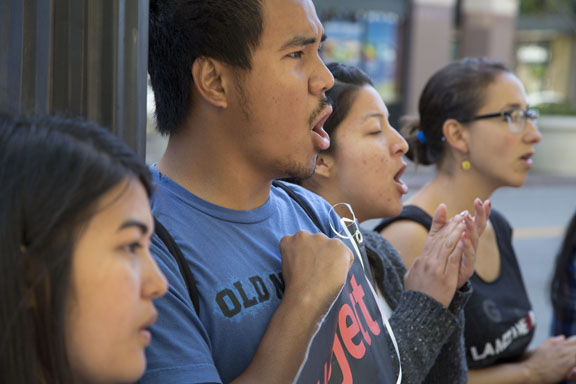Fixing a broken immigration system
by David Bacon
The American Prospect
When President Obama appointed Dollie Gee to the U.S. District Court in 2010, he undoubtedly didn’t expect her to mount a frontal challenge to his administration’s detention and deportation policies. But five years after her elevation as the first Chinese American woman on the federal bench, Gee ruled last summer that holding Central American women and children in private detention lockups was illegal.
Gee didn’t mince words. She called the detentions “deplorable.” And she denounced as “fear-mongering” the claim by Homeland Security lawyers that the detentions would discourage more people from leaving Central America.
Her angry tone shouldn’t have come as a surprise. Gee’s father was an immigrant engineer and her mother a garment worker in a Los Angeles sweatshop. After law school, as a young lawyer, Gee sued employers for discrimination and then worked for the Teamsters Union, helping workers and immigrants win representation elections. For Chinese Americans, today’s detentions contain ugly echoes of the Chinese Exclusion Act of 1882, which led to the brutal detention of thousands of Chinese immigrants on Angel Island in San Francisco Bay 128 years ago.
Gee ruled that imprisoning families violated the Flores Settlement, an agreement by the federal government in 1997 that it would release children whenever possible, and hold them in the least restrictive conditions when it could find no one to care for them. But the U.S. appealed Gee’s ruling, handed down in August of last year, and in December the Obama administration announced that it would begin deporting Central American migrants who had arrived after May 2014, and who had lost their appeals before immigration judges. Agents then picked up 121 people, including women and children, and sent them to detention centers in Texas.
Homeland Security Secretary Jeh Johnson, defended the action. “Our borders are not open to illegal migration,” he said at a press conference. “If you come here illegally, we will send you back consistent with our laws and values.”
The statement captures one side of the administration’s contradictory treatment of Central American immigrants. On the one hand, President Obama acknowledges that families crossing the border are fleeing violence at home in Central America. On the other, he blames people for coming.
The latest wave of women and children from Honduras, El Salvador, and Guatemala began arriving on the U.S. border in 2014, prompting the antiimmigrant Breitbart News Network to launch a campaign of hysteria. Agents at the U.S. Customs and Border Protection agency, presumably at the behest of conservatives within their ranks, chimed in with allegations that detention centers were being “flooded” by Central American children.
In response, the Obama administration pushed forward construction of two privately run facilities in Texas, designed to hold 1,500 people between them. When immigrant advocates voiced outrage, the administration began processing asylum claims more rapidly, to shorten stays in the centers. At the same time, the administration defended its much broader decision to defer the deportation of family members of legal residents and citizens. When a Texas judge declared that decision illegal in 2014, the administration began a long appeals process that has now brought the case before the Supreme Court. Twenty-six states, almost all with Republican governors, joined the suit against the Obama order.
Both the administration’s threats and detentions have failed to reduce migration, however. Some 58,650 non-Mexicans were picked up on the U.S.-Mexico border during the last three months of 2015. The number of unaccompanied children apprehended was 17,370, compared to 7,987 during the same period the year before, while the number of families went from 7,468 to 21,469.
Blaming the wave of migration on “violence” is far too simple. Modern migration from Central America began with the counterinsurgency wars of the 1980s. The Reagan administration cast as a Cold War threat what were essentially civil conflicts to change societies dominated by wealthy elites, and intervened to support militaries and contras. As U.S.-backed armies and contras waged war on civilians, hundreds of thousands of people fled.
Sergio Sosa, a Guatemalan immigrant who now directs Omaha’s Heartland Workers’ Center, recalls bitterly: “The U.S. was responsible for the coups that happened in Guatemala in 1944 and later in ‘54. Our army was trained at the School of the Americas, and they would come back afterwards and kill our own people. The U.S. used its power and we buried the dead.”
An estimated 500,000 Salvadorans arrived in the U.S. in the 1980s, and tens of thousands more fled Honduras and Guatemala. As a result, thousands of families have been separated for decades.
Many settled in the poorest and most dangerous neighborhoods of big U.S. cities, including Los Angeles, and were recruited into gangs. The Los Angeles police-many of whom were later found guilty of robbery, murder, and selling drugs themselves-launched the notorious Community Resources Against Street Hoodlums (CRASH) program that arrested and deported young immigrants by the thousands.
But instead of convincing young people in L.A. not to join gangs, deportation spread gang culture through Central America. The name of the Trece (13) gang, for instance, refers to 13th Street in Los Angeles, not in Tegucigalpa.



